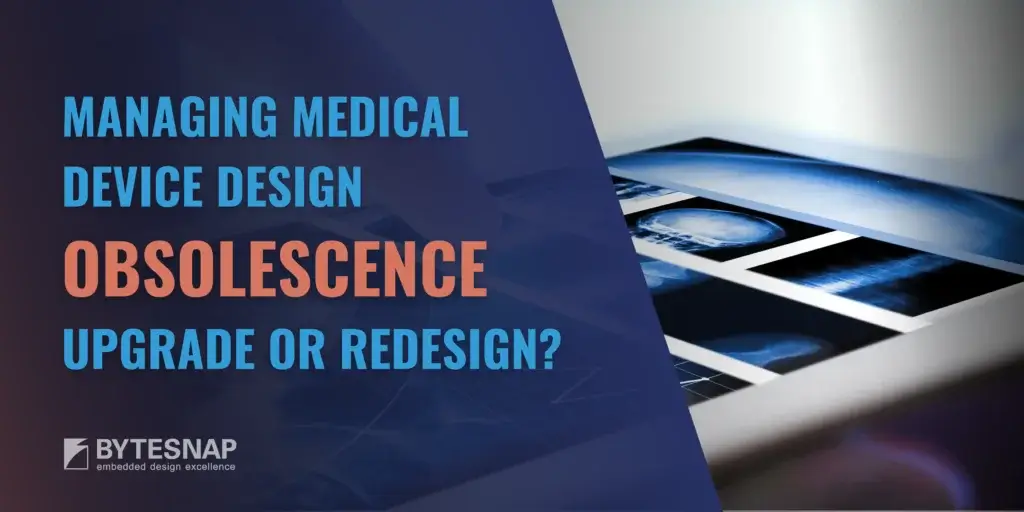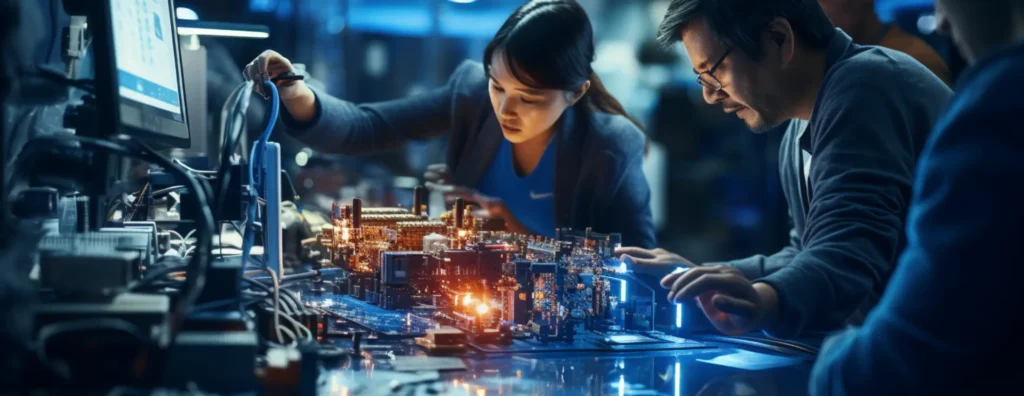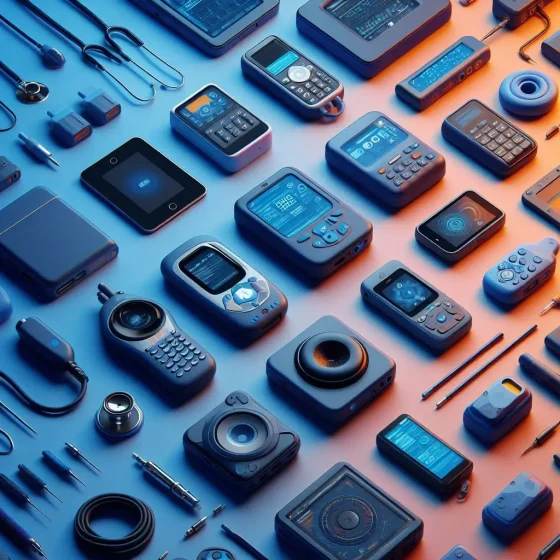Managing Obsolescence in Medical Device Designs
With the rapid pace of technological change, product obsolescence poses increasingly complex challenges across the medical device industry.
As devices become more integrated with software, analytics and connectivity capabilities, system architectures grow more sophisticated.
Components face shorter lifecycles before becoming outdated or unsupported.
The UK’s medical technology sector, chiefly comprised of SMEs spread across the country, is expected to reach £25.8bn by 2028, making it an extremely profitable industry.
However, success in this sector remains an uphill task for manufacturers and innovators.
Starting from scratch with brand-new products can take 4 to 5 years of research, development, rigorous testing, regulatory compliance and approvals, and certification.
The costs can easily reach millions of pounds for small and medium-sized businesses that do not have a lot of resources.
Instead of giving up and giving in to the rising tides of obsolescence, medical device companies can deal with these problems by
strategically upgrading legacy products to make them last longer.
So, how do you decide – upgrade or redesign?
Effective risk management across the product development process is crucial. Your compliance and manufacturing processes must be carefully managed too.
If your company does not have the means to do this on its own, the best thing to do is to work with experts in medical device design.
We will talk more about this in this article.

Key Considerations for Navigating Obsolescence in Medical Device Design:
- Discussing the need for a comprehensive approach to assess obsolescence risks, including hardware, software, and connectivity factors.
- Focusing on the importance of security upgrades in connected medical devices and examining strategies for maintaining security.
- Exploring how enhanced connectivity and data analytics can be used in IoT medical devices.
- Analysing the decision-making process between upgrading existing devices and redesigning new platforms.
- Outlining the regulatory landscape and how to navigate it during the process of upgrading or redesigning medical devices.
- Highlighting the benefits of upgrading legacy devices, such as reduced costs, enhanced capabilities, and increased profitability.
TLDR – main points of the article.
- Ultimately, strategic upgrades can turn challenges into opportunities, enhancing competitiveness and sustainability.
1 Assessing Obsolescence Risks Holistically

In assessing the risk of obsolescence in medical technology, it’s good practise to consider a comprehensive approach that includes hardware, software, and connectivity factors.
For example, integrated circuits, field programmable gate arrays (FPGAs), and other hardware parts may reach a point where they are no longer made, which would mean that redesigns would have to be done.
Legacy firmware and operating systems — Windows CE, for example — can introduce dangerous security vulnerabilities and bug issues in connected IoT medical devices.
Also, consider how evolving wireless networks and communication protocols can leave previously connected devices coverage-constrained.
Digital Health Device Case Study
2 Prioritising Security in Medical Device Development
With rising healthcare breaches, urgent security upgrades are crucial for protecting data and upholding patient safety.
Legacy operating systems lack modern defences and can be vulnerable to cyberattacks if robust security support and updates are not carefully planned for and maintained.
Assess firmware for vulnerabilities, such as buffer overflows or denial of service. Partner with consultants deeply versed in protocols like DICOM, HL7 and FHIR.
For Wi-Fi security, be sure your devices and systems are updated to WPA2 at least – ideally, update them to WPA3.
Cellular: consider migrating to 4G LTE or Narrowband IoT, incorporating transport layer security. Enforce encryption and two-factor authentication.
Make sure that regular patching and key rotations are maintained to boost protection.
3 Optimising Connectivity and Data Analytics
Advancing connectivity leads to significant data insights through cloud analytics. Medical tech consultants can use NB-IoT and LTE-M to provide wide coverage with low-power, wide-area network protocols.
This facilitates continuous health monitoring and the development of predictive models.
Collaborating with edge computing experts allows for analysing crucial data on the device and sending only essential data to the cloud.
Firmware updates can improve user experience by adding Bluetooth Low Energy (BLE) support for smartphone app integration.
Effective use of data analytics also requires compliance with HIPAA regulations and ensuring strong data security.
4 Deciding Whether to Upgrade vs. Redesign Your IoT Medical Device or System
For manufacturers, a crucial question is whether upgrading legacy devices makes strategic sense versus redesigning new platforms.
Experienced embedded systems consultants can provide vital insights on this decision. They weigh up factors such as:
- Remaining product lifespan
- Customer demand
- Cost considerations
- Technology roadmaps
Other factors to assess include the effort required to enhance security, comply with new standards, and boost connectivity. The return on investment from improved analytics and additional features should also be evaluated.
In some instances, for extensive upgrades, a complete redesign might spread the costs over a longer period.
Upgrading older devices can sometimes be faster and cheaper than creating new products. This can meet customer needs and extend the profitable lifespan of the product.

5 Navigating Regulatory Requirements
When developing connected medical devices, harmonising innovation with regulatory compliance is essential. Minor firmware updates might not require recertification, but more significant modifications often do.
Product design experts proficient in standards like IEC 62304, ISO 13485, ISO 14971, and IEC 60601 are essential for developing compliant solutions. They can provide you with guidance on refining quality management systems and change control procedures.
Your outsourced developers will make sure that requirements, design, implementation, and testing for software-based enhancements are all coherently linked.
These experts can help you innovate quickly and reduce risks in regulatory submissions due to their extensive knowledge of global regulations.
6 Realising the Benefits of Extending Lifecycles
Upgrading legacy medical devices with support from expert product design consultants provides several benefits, including:
- Accelerated time-to-market: Upgraded products can hit markets in a matter of months, rather than 4-5 years for new platforms.
- Reduced costs: Strategic upgrades minimise expenses versus building entirely new solutions.
- Enhanced capabilities: Modernised devices gain advanced connectivity, usability, security, and analytics.
- Increased profitability: Extended product lifecycles help to preserve revenue from proven devices.
- Environmental sustainability: Upcycling reduces e-waste by keeping products usable for longer.
7 Key Takeaways
- To modernise obsolete medical devices, specialised engineering expertise is essential.
- Rather than taking months developing internal skills, partnering with experienced consultants saves significant time and cost.
- The ideal development partner offers deep understanding of the original product design and subsequent modifications. They can identify replacement parts that integrate into the existing architecture.
- Rewriting firmware in newer languages enhances security, connectivity and analytics abilities.
- With software-centric devices, balancing innovation and regulatory compliance is key. Minor updates may not require recertification, but substantial changes probably will.
- Working with regulatory-savvy engineering consultants allows for practical solutions and lowers the possibility that changes would unintentionally impact critical performance and safety criteria.
8 Treat Mastering Obsolescence as a Core Capability
Medical device manufacturers face various technical and business challenges due to obsolescence. However, companies that embrace strategic upgrades can turn these challenges into opportunities to improve their bottom lines and competitiveness.
Legacy products can be cost-effectively modernised to deliver ongoing value instead of ending up in landfills.
Ultimately, by taking a proactive and creative approach, manufacturers can master medical device obsolescence as a core capability that fuels innovation.
Ready to manage obsolescence in your medical device design efficiently?
ByteSnap’s experienced consultants can help you assess the top development priorities for your project and support your engineering team, whether you decide to go for a product upgrade or redesign.
Ready to start?
Further reading
About the Author

Dunstan is a chartered electronics engineer who has been providing embedded systems design, production and consultancy to businesses around the world for over 30 years.
Dunstan graduated from Cambridge University with a degree in electronics engineering in 1992. After working in the industry for several years, he co-founded multi-award-winning electronics engineering consultancy ByteSnap Design in 2008. He then went on to launch international EV charging design consultancy Versinetic during the 2020 global lockdown.
An experienced conference speaker domestically and internationally, Dunstan covers several areas of electronics product development, including IoT, integrated software design and complex project management.
In his spare time, Dunstan enjoys hiking and astronomy.




